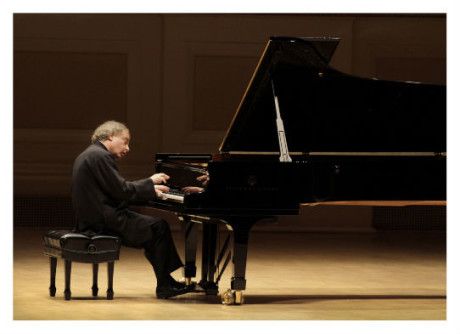If there is a spiritual content to music – music by itself, no lyrics, just abstract sound – then many listeners down through history have claimed to hear it in the final works of great composers. The closest you’re likely to come to discovering that for yourself is to hear pianist András Schiff play these compositions.

Last Wednesday night Mr. Schiff brought the final sonatas of Haydn, Mozart, Beethoven, and Schubert to The Music Center at Strathmore. Mr. Schiff carries a special brand of Old World charm and a clarity of articulation that especially opens up the sound world of the end of Beethoven’s last sonata and the first movement of Schubert’s last sonata. Both of these passages of music tend to impel many individual listeners to a contemplation of matters above and beyond.
Still, the idea of automatically classifying the entirety of the four classical giants’ last piano sonatas as an apotheosis of tragedy or transcendence is only approximate, as Mr. Schiff freely admits in his commentary. Schubert may have finished his last sonata a month before he died, but Beethoven’s Piano Sonata No. 32 gives away its chronology for being universally known among musicians as “the Opus 111 sonata.” Even the Ninth Symphony came later, clocking in at Opus 125 in Beethoven’s catalog of published compositions.
Mozart’s 18th and final piano sonata is a bit of a historical accident in its reason for composition and actually sounds rather jolly, given that Mozart obviously had no premonition of dying early two years later. And Haydn would probably be composing the same sort of jaunty figures and sunny runs if he lived for 200 more years up to the present day.
But Mozart’s final sonata in D major (for sticklers, K. 576 in the Köchel listing of all 626 of Mozart’s officially catalogued compositions) is really a special treasure for incorporating an adept form of counterpoint, or multiple simultaneously spinning lines, that Mozart developed later in his short life from an increasing study of Bach. Sparkling and yet also expressive counterpoint is one of Mr. Schiff’s globally recognized distinctions as a keyboardist. Not only were the outer two movements superbly performed but the middle, lyrical movement featured incredibly lovely tones out of Mr. Schiff’s Bösendorfer concert grand. As if to underline Bach’s influence on all of the composers for the evening, at the end of the concert Mr. Schiff performed an encore of the opening theme of Bach’s Goldberg Variations.
But many concert-goers came especially for the last Beethoven sonata. The second half of this C minor sonata is a theme and variations that performers struggle to perform in a way that listeners won’t automatically associate with later musical concepts. That’s particularly true of a passage that can sound like a precursor of “boogie-woogie” but is really one among a series of rhythmic variations that eventually morph into a set of ethereal trills.
Schiff is an ideal performer to get this across because he communicates pianistically the “overcoming of struggle” – remember, Beethoven was deaf when he wrote this stuff – inherent in the trying out of rhythms that really do end up sounding like an invocation of heaven in the final trills. Instead of making “jazz” out of the device, Schiff contains his volume to a certain level while making sure to put air between all the notes, no matter how fast they are. The fantastic acoustics of Strathmore help in this by ensuring that even contained tones reach the back row.
Mr. Schiff achieved an analogous effect at the opening of the Schubert sonata, which starts with what sounds like a placid stream of melody but is interrupted by a disturbing trill almost at the bottom of the piano. I particularly liked how Mr. Schiff did not make any kind of virtuosity out of this moment. Instead he spun the low trill at a moderate speed and tailed off the final three-note figure rather than landing ponderously on it. It held the promise of a mystery to be solved over the entire length of Schubert’s sometimes meandering four-movement sonata.
Alas, the concert did have one atmospheric challenge – the impatient behavior of some of the audience. Some “lovers” of serious music do not always understand that music – especially in the sublimity of this particular concert – consists of both sound and silence. The eternally puzzling habit of many classical audiences (in this country at least) to cough incessantly was exacerbated by the fact that some of them seemed to think that Beethoven and Schubert’s rests were the right place to do it. Of course those are the wrong places to do it, made even worse by the fact that Strathmore’s acoustics amplify the sound of both the performers and the audience!
It may also explain why Mr. Schiff visibly reacted negatively, in an incident already reported in the Washington arts media, to a know-it-all audience member who decided to demonstrate that he knew exactly where the Beethoven sonata ended by starting his applause right after the chord sounded but while Mr. Schiff was letting the notes ring and continuing to hold his hands over the keyboard, in a universally understood gesture that means “keep listening until I drop my hands to indicate that Beethoven is done saying what he has to say.” Washington Performing Arts has done a great job bringing Mr. Schiff, one of the world’s most revered and recorded living classical artists, to Washington no less than three times in one year. Hopefully he’ll still say yes when they ask again.
Running Time: 2 hours with one 15-minute intermission.
Pianist András Schiff presented by Washington Performing Arts appeared on Wednesday, February 24, 2016 at The Music Center at Strathmore – 5301 Tuckerman Lane in North Bethesda, MD. For all future events presented by Washington Performing Arts, see their season calendar.




